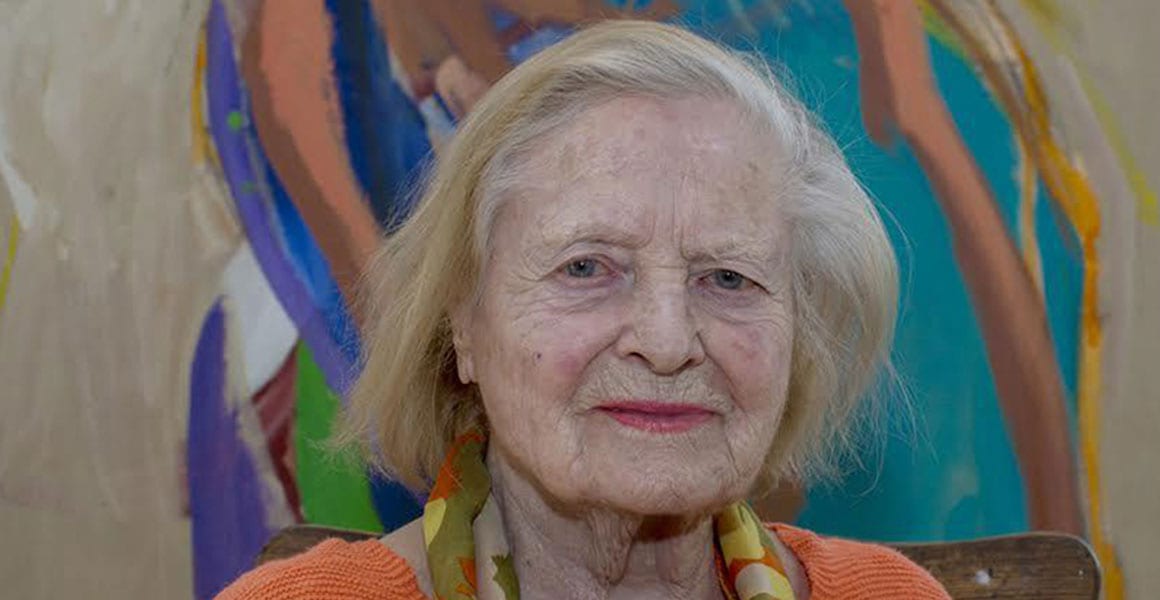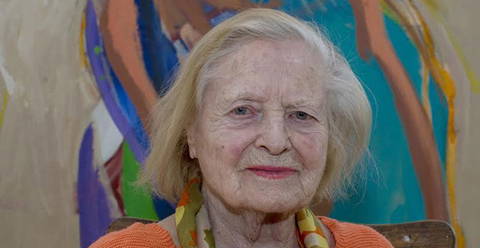
Quintessentially American in many ways and as if being related to John Adams and gracing the cover of Vogue wasn’t enough, she was most notably a major player in the abstract expressionist movement of the ‘50s – although she often wasn’t given the credit that was due to her.
She was known lovingly as “the crazy art lady on 3” in Manhattan’s SoHo neighborhood where her studio remained only until about a decade ago. Abbott was a woman who did her own thing, in her way and often went against the status quo of her time.
As an homage to Abbott and her impressive career as a female artist in the 20th century, here are six facts you should know about the woman and her life.
1. Abbott’s Interest in Drawing Took Hold as She Recovered from an Ailment as a Child

As you might recall, Warhol started drawing during his time recovering from a nervous system disease called Sydenham’s chorea. All those hours bedridden were, therefore, put to good use. Abbott had a similar childhood experience that led her to fall in love with drawing.
At age 9, she developed an infection behind her ear which was later complicated by pneumonia. She was bedridden for two years which sparked a newfound relationship with not only art but nature, too.
Abbott would continue to follow this passion for creating in nature for the rest of her career and life.
2. She Appeared on the Covers of Vogue and Harper’s Bazaar

Initially, Abbott moved to New York’s East Village, not to be an artist but for her modeling career. She earned early renown as a fashion model and was featured on the cover of big magazines like Vogue, Glamour, and Harper’s Bazaar in the 1940s.
It was in 1946 that she moved into her East Village apartment as a model and began to rub shoulders with the neighborhood’s exploding avant-garde art scene. She started painting and was friends with David Hare, mentored by Mark Rothko and Barnett Newman, and discussed art with Jackson Pollack at the Cedar Street Tavern.
3. She Hated Pollock but Was Close Friends (and Lovers) with Willem de Kooning

According to a book by Mary Gabriel called Ninth Street Women, Abbott said of Pollock, “his way of making friends was to knock you down and get on top of you.” That’s right – Abbott is here recalling how Pollock once assaulted her although she managed to fight him off.
It’s safe to say that she hated the guy. De Kooning, on the other hand, was a dear friend and, at one time, Abbott’s lover.
In the early ‘50s, Abbott dedicated Bill’s Painting to him and said he was the love of her life. De Kooning proposed marriage to Abbott twice, to which she refused, noting that it would have ended his art career. Not to mention, she thought he was a bit of a handful although they maintained a close friendship regardless of their relationship status.
4. She Was not Part of the Exhibition Known for Its Role in Introducing Abstract Expressionism

Unfortunately, it’s not surprising that as a female artist in the 1950s, she had a hard time receiving much recognition for her artistic contributions. But, to be fair, even the men in her field of abstract expressionism weren’t receiving much acclaim at the time.
Plus, Abbott was known to be a modest woman and often felt uncomfortable promoting her work. This disposition, as well as the obvious sexism that ran rampant at the time, didn’t help her cause.
Abbott’s work was exhibited a few years later though, at the Stable Gallery in a series of shows. Her art was also shown more recently at the 2016 Women of Abstract Expressionism exhibition in Denver alongside Helen Frankenthaler, Joan Mitchell, Elaine de Kooning, and Lee Krasner.
5. Abbott Spent Significant Periods in Haiti and St. Croix

In 1943, Abbott married R. Lewis Teague, a painter in the Army but the two separated after only three years – a risky move for a woman in the ‘40s. It was then that she refocused on her painting and ended up in the U.S. Virgin Islands to settle her divorce.
There, she met businessman Tom Clyde in 1949 while in the Caribbean and they were married by 1950. Clyde’s poor health meant they spent significant time in places like St. Croix and Haiti for the desirable weather. There, Abbott would chase down snakes and paint the majestic landscapes of the islands.
Unfortunately, this marriage also ended in divorce.
6. Abbott Often Painted Nature Scenes

Her time in the Caribbean inspired many of her landscapes and she often painted lush forests and hillsides that she found on the islands where she lived. Gwen Chanzit from the Denver Art Museum said, “While we often think of abstract expressionism in terms of bravado, I think that Mary Abbott’s paintings were more about emotional gesture, about her inner response to the world.”

Essentially, Abbot found a way to “talk” through her abstract art and it was a lifelong journey for her. Although her influence on abstract expressionism is often overlooked, we’re grateful for her persistence and undying spirit.
Her legacy will live on, although her absence will surely be felt in the art world and by those who loved her. Abbott leaves behind a half-sister and was one of the last links to her generation of artists that changed international art forever. Rest easy, Ms. Abbott.




